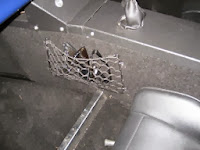Some investigations today.....
Rewired right back to the ECU and double checked the wiring - all OK. Walked back through the set-up advice from Emerald: Wire one pin on the valve to an ignition fed +12v supply. The other side goes to pin 3 (IACV Valve channel 1) on the Emerald ECU. In the PC software go to ECU Configuration and "Idle Air Control Valve motor options" and select 300Hz as the PWM value. If the configuration has to be changed then click the OK button and reset the ECU by switching the ignition on and off. Read up the map from the ECU and go to the "Idle Control" tab - press F5. Select “motor control mode” in the top right hand corner of this screen. Set the mode to “Fixed position manual control." Re-program the map to the ECU.
From the "live adjustments" tab (F8), and with
ignition ON, engine OFF, use the page up/page down keys to alter the motor
setting. The valve is, in effect, an air
injector so you should hear the motor buzzing as you increase the IACV position
above about 20%. Note that the valve
will not work at very low settings or very high settings - the normal operating
range is between 30% and 70%. You can
test this before starting the engine when the valve noise should be very
obvious.
Everything behaved exactly as per the above - thought I had finally cracked it....but.......with the engine fired up (cold) the IACV had no effect on the idle regardless of the position (0% through 100%) which remained stubbornly at c 1000RPM.
- With my finger partially over the inlet pipe it showed that air was passing through the value - I could hear it and feel it and the engine revs dropped accordingly.
- With my finger completely over the inlet pipe and the engine cut out, so no air leaks into the manifold.
Then I removed the pipe connecting the IACV to the manifold and allowed air directly into the manifold via the pipe i.e. no IACV at all. The revs jumped up to 1200RPM. This looks like the problem. There is simply not enough air being allowed through the IACV due to the diameter of the inlet pipe and bracket. Surprising since this was a GBS design.
This diagnosis is also supported by that fact that RichardL has his working by connecting directly to the Plenum chamber i.e. no pipes or brackets to restrict the airflow.
So what to do? - not sure. I don't particularly want to remove the manifold to fit the IACV, but I may have to. I'll think on it.




